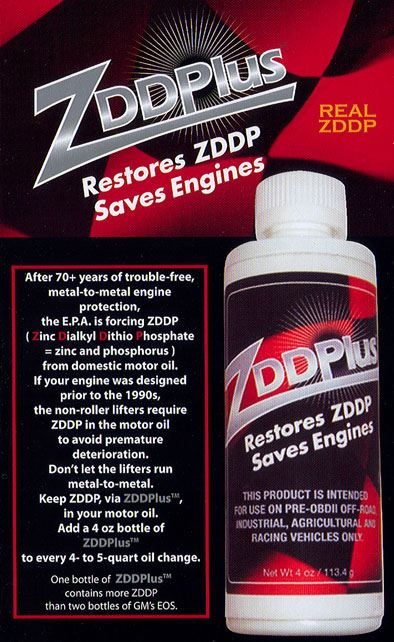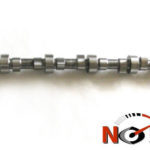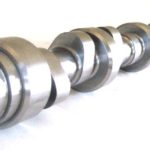Description
ZDDPLUS
What Is ZDDP?
To quote one 2005 research study: “The most common antiwear additives used in engines are zinc dialkyldithiophosphates (ZDDPs), which have the chemical formula Zn[S2P(OR)2]2, where R isan alkyl group. ZDDPs have successfully been used for over 60 years, and to date no superior antiwear additive has been developed for use on steel.”
Why is it being removed?
Because contemporary engines with roller bearings no longer require the additional protection of
Zinc and Phosphorus. Not true for classic cars, tractors, muscle cars, etc. Also removing the Zinc and Phosphorus from motor oil increases the life of the catalytic converter. But classic cars, tractors, etc., don’t have cats! Also, as part of its ongoing effort to reduce vehicle emissions, the EPA has mandated that emission systems must have a service life exceeding 120,000 miles. To achieve this, automotive manufacturers have required oil suppliers to remove additive packages from motor oils that could reduce emissions compliance.ZDDPlusTM is the ONLY EP (Extreme Pressure) component which reestablishes the ZDDP levels that our classic car engines were designed for, while allowing the car owner to use the base oil of their choice. While some offthe-shelf additives may have some ZDDP, the amount per bottle is small, and when enough is used to get the proper concentration of ZDDP, there is a quart or more of unspecified oil that comes along with it. This dilution of 20% of your oil with an unspecified oil also means that there is 20% less of the proper additive package. The chart below compares the amount of ZDDP in ZDDPlusTM to GM EOS, an additive which claims to provide ZDDP based wear protection.
Why do we need ZDDPlusTM?
As part of an effort to reduce vehicle emissions, the U.S. EPA offers vehicle manufacturers “credits” for early implementation as well as penalties for violation of emission reduction
standards. The EPA’s program called for 100,000mile catalytic converter life by 2004, 120,000 miles by 2007, and 150,000 miles by 2009. To achieve these goals, automotive manufacturers havepressured their oil suppliers to remove substances from motor oils that would shorten the service life, including the proven EP (extreme pressure) additive ZDDP (zinc dialkyldithiophosphate). Zinc and phosphorus from the ZDDP can be present in small amounts in the exhaust gas of an engine depending on the amount of oil which is consumed in combustion. These elements can coat the catalyst reducing the amount of catalyst exposed to the exhaust gases, ultimately increasing emissions at the tailpipe. As a result of the EPA mandate, the ZDDP level in engine oils has been declining since the mid1990s, roughly coinciding with the implementation of OBDII. ZDDP has been an important additive to engine oils for over 70 years, and has an excellent track record at protecting the sliding metal to metal cam lifter interface. Historically, ZDDP has been added to oils in amounts resulting in approximately 0.15% phosphorus, and 0.18% zinc. ZDDP protects by creating a film on cams and flat lifter contact points in response to the extreme pressure and heat at the contact point. The film of zinc and phosphorus compounds provides a sacrificial wear surface protecting the base metal of the cam and lifter from wear. In the course of normal service, this conversion of ZDDP to zinc and phosphorus compounds depletes the ZDDP level in the oil. Studies show that depending on the specific engine and severity of duty, after 2000 – 4000 miles of operation, the level of ZDDP can drop below that considered adequate to provide wear protection to the cam and lifters.
According to the SAE Tech Bulletin # 770087 [1] , operation of a flat tappet engine without adequate EP additives such as ZDDP quickly leads to lifter foot scuffing and cam lobe wear. Camshafts are typically only surface hardened leaving the core ductile for strength. According to the SAE Bulletin, once cam lobe wear reaches 0.0002, “subsequent wear is usually rapid and catastrophic.” Two tenthousandths of an inch is one fifth the thickness of an average human hair.
In order to make engines last in the absence of ZDDP, virtually all IC (internal combustion) engines designed in the last ten years utilize roller lifters. Today, ZDDP has been removed from practically all automotive engine oils, rendering them unsuitable for use with older engines with nonroller lifters.



